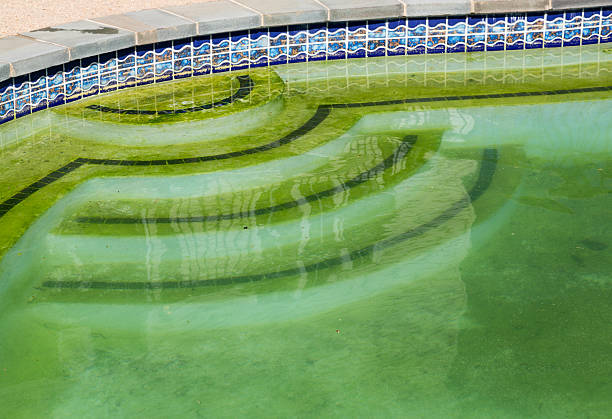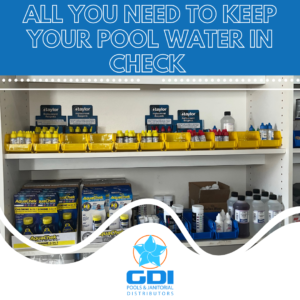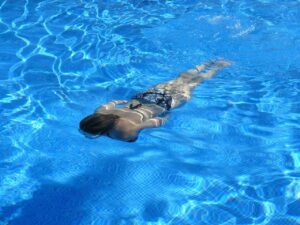What causes algae in pool water?
1) Low Chlorine levels
2) Sunlight
3) Heat
4) Heavy pool usage
5) Vegetation in the pool
Algae is typically caused by a lack of proper filtration or sanitation. Proper and consistent cleaning will greatly reduce algae growth in your swimming pool. Daily circulation and balanced chemicals will also help keep your water in check. A wise man once told me, “A stagnant pool is nothing less than a swamp.”
Quick tip – Take extra precaution when cleaning your pool after a pool party or bad weather. We recommend boosting the chlorine levels by using shock. Shock works best if you pour it in the water at night, eliminating the risk of burn-off from sun and heat. Make sure to brush the walls, vacuum and run the circulation before shocking your pool.
How do you get rid of Pool Algae?
To be sure which type of algae is in your pool—which will determine how you get rid of it—take a close look at any spots where algae is starting to grow.
Green algae: The most common and easiest algae problem to kill is chlorophyta, which gets its color from chlorophyll. Green algae floats in the water, making it cloudy and giving it a greenish tinge. Slimy green algae also attaches itself to your pool walls and floor. Poor filtration and lack of proper sanitization boost green algae growth. It can be introduced to your pool by swimwear and toys that have been used in natural bodies of water that contain algae.
How to get rid of green algae:
Test your pool water. Add chemicals as needed to ensure that your pool water is balanced before you start the algae removal process.
Shock your pool with a chlorine shock treatment. Run your filter for at least 24 hours after you add the shock treatment.
Scrub away the green algae. Use a pool brush to scrub the algae off of your pool walls.
Add algaecide. Most pool supply retailers sell algaecides that are specially formulated to remove green algae.
Scrub (again) and vacuum. Take a second pass with your pool brush to remove any remaining green algae. Follow up by vacuuming your pool. This will remove any dead algae that has collected at the bottom of the pool.
Yellow algae: If you see what looks like pollen or sand in a shady corner of your pool, you probably have yellow algae. It’s also sometimes called brown or mustard algae. It’s rare, and not slimy like green algae. It’s also chlorine-resistant, which makes it tough to treat, whatever name you call it—even the four-letter names.
How to get rid of yellow algae:
Clean everything that has come into contact with your pool water. Wash swimsuits and towels (use bleach!), and make sure to clean and disinfect pool toys and equipment. Remember, yellow algae spores can survive on almost any surface, so this step is critical!
Scrub and vacuum your pool. Use a good pool brush to scrape yellow algae off of your pool walls. Once you’ve removed all of the algae, vacuum your pool thoroughly.
Test and the water. If anything is out of balance – say, the pH is too high or the alkalinity is too low – add chemicals to bring things into line.
Brush the pool (again). This will help ensure that you get any remaining algae.
Shock your pool. You’ll need to use around three times the amount of shock treatment than you’d use for green algae. Run your pool filter for at least 24 hours to ensure that the shock treatment can circulate.
Repeat steps 3, 4, and 5 as needed. Test, brush, and shock your pool as needed, until your pool is 100% algae-free and your water chemistry is balanced.
Black algae: Technically a cyanobacteria—not algae at all—this nasty offender makes its own food, so it grows and grows. Not only that, its roots dig into concrete surfaces, making it tough to kill black algae in your pool. It’ll grow back quickly if your treatment isn’t aggressive enough to ensure none of the roots hang around.
How to get rid of black algae:
Clean your filter. Chances are good that if your pool has black algae, your filter probably has it, too.
Scrub the black algae away with a good, stiff pool brush. This will help break down the protective layer and make it easier to treat.
Break a chlorine tablet in half and rub it directly onto the affected areas. The chlorine treatment will kill the algae’s roots and prevent it from coming back.
Shock your pool. Because black algae is tougher than other types of algae, you might need to use a stronger dose of pool shock. Check the directions on the package or talk to your local pool supply retailer.
Add algaecide to your pool. This will help keep the black algae from growing back.
Run your pool filter. Keep it running for at least 24 hours to ensure that the treatments and chemicals can circulate properly.
Test your pool water. Keeping your water chemistry balanced can help prevent future outbreaks.




